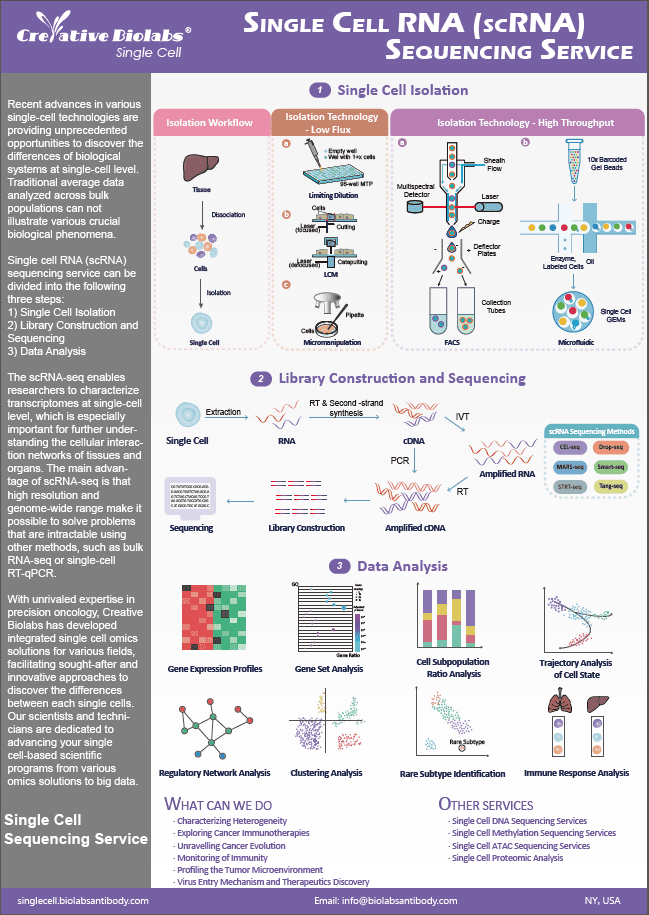Single Cell Multi-Omics Services
Creative Biolabs is a good partner of pharmaceutical companies and research institutions. We provide single cell multi-omics services to accelerate your project progress.
Single Cell Multi-Omics
Multi-omics analyses have been shown to be useful in gaining a thorough understanding of biological activities. This advantage has facilitated the development of single cell multi-omics analysis, which allows researchers to investigate cell type-specific gene regulation. (1) single cell isolation, barcoding, and sequencing technologies to measure multiple types of molecules from the same cells, and (2) integrative analysis of the molecules measured at the single cell level to identify cell types and their functions related to pathophysiological processes based on molecular signatures are the core components of single cell multi-omics analysis.
 Fig.1 Strategies for multi-omics profiling of single cells.1, 3
Fig.1 Strategies for multi-omics profiling of single cells.1, 3
Single Cell Triple Omics Sequencing Service
Creative Biolabs offers single cell triple omics sequencing service to analyze genomic CNVs, the DNA methylome, and the transcriptome of an individual mammalian cell simultaneously.
Learn MoreAnalysis of Single Cell Multi-Omics Data
Multi-group analysis can quickly collect a significant amount of data. By merging the research findings with the key analysis, the results can be generated rapidly. The data from omics at various levels may be cross-verified, making the experiment's conclusion gained through extensive analysis more credible. Multi-layer omics integration can compensate for the shortcomings of single-layer omics in detecting preference differences. The fault induced by the difference in preference in single group detection can be compensated for by multilayer omics integration. It is simpler to discover the difference by evaluating downstream omics data, as there is a propensity to intensify the influence from gene to protein to metabolism.
The approaches developed for single cell mono-omics data have been extended and merged for the integrative analysis of single cell multi-omics data. The methodologies are: (1) single-cell mono-omics data correlation analysis; (2) analysis of one kind of single cell data followed by integration of another single cell data type; and (3) integrative analysis of all types of single cell omics data to generate the overall single cell map.
 Fig.2 Strategies for the integrative analysis of single cell multi-omics data.2, 3
Fig.2 Strategies for the integrative analysis of single cell multi-omics data.2, 3
Applications of Single Cell Multi-Omics
- To identify cell subtypes from a heterogeneous cell population
- To reconstruct cell lineage trajectories
- To definitively reveal the relationship between different omics readouts
Advantages of Our Multi-omics Service
- In-depth investigation of potential pathogenic variables: including integrating genomes and transcriptomics data and analyzing the multi-layer response to disease onset
- Construct a gene regulatory network: A network link exists between genes, mRNA, regulatory factors, and proteins in an organism. The numerous chemicals are linked together through the creation of gene regulatory networks.
- Multi-omics analysis: For example, the influence of candidate genes screened at the DNA level on transcription, mutation analysis at the RNA level for genes that are considerably differentially expressed at the RNA level, and integrated analysis based on metabolite related enzymes and differential genes.
Creative Biolabs can customize exclusive solutions for you based on your projects and needs. Please contact us for more information about our single cell multi-omics services. Our experts will help design an optimal solution for your project and trouble-shoot for you throughout the whole process.
Q&As
Q: How does Single Cell Multi-Omics improve upon traditional methods?
A: Traditional methods often analyze bulk populations of cells, masking the heterogeneity within. Single Cell Multi-Omics provides high-resolution insights into cellular diversity, revealing unique cellular states and interactions that drive disease progression and therapeutic responses.
Q: How can Single Cell Multi-Omics aid in cancer research?
A: Single Cell Multi-Omics helps identify genetic and phenotypic heterogeneity within tumors. By linking genetic mutations to specific cellular behaviors, researchers can better understand tumor progression, therapy resistance, and potential therapeutic targets.
Q: How does Single Cell Multi-Omics contribute to personalized medicine?
A: By providing detailed profiles of individual cells, Single Cell Multi-Omics can identify patient-specific biomarkers and therapeutic targets. This approach supports the development of personalized treatments that are tailored to the unique cellular makeup of each patient's disease.
Q: How does Single Cell Multi-Omics enhance diagnostic capabilities?
A: This technology can consolidate multiple diagnostic tests into a single assay, providing a comprehensive view of cellular states and interactions. It enhances the accuracy of diagnoses and enables the detection of rare cellular subpopulations that may drive disease.
Q: How do Single Cell Multi-Omics handle data complexity?
A: Advanced bioinformatics tools and integrative analysis platforms are used to manage and analyze the vast amount of data generated, ensuring accurate interpretation and meaningful insights from the multi-omics datasets.
Resources
References
- Hu, Youjin et al. "Single Cell Multi-Omics Technology: Methodology and Application." Frontiers in cell and developmental biology vol. 6 28. 20 Apr. 2018, doi:10.3389/fcell.2018.00028.
- Lee, Jeongwoo et al. "Single-cell multiomics: technologies and data analysis methods." Experimental & molecular medicine vol. 52,9 (2020): 1428-1442. doi:10.1038/s12276-020-0420-2.
- Distributed under Open Access license CC BY 4.0, without modification.
Related Sections
Search...


